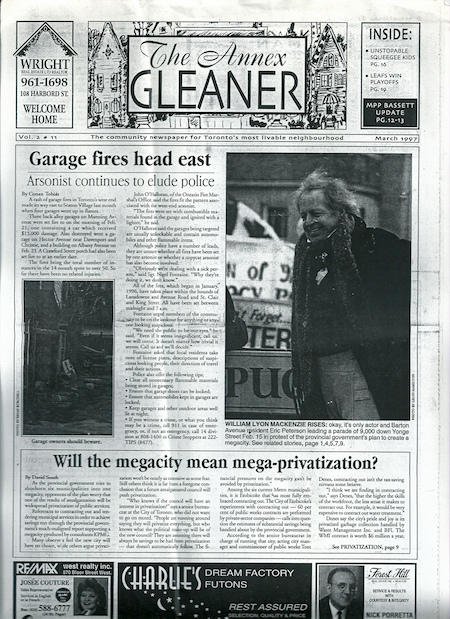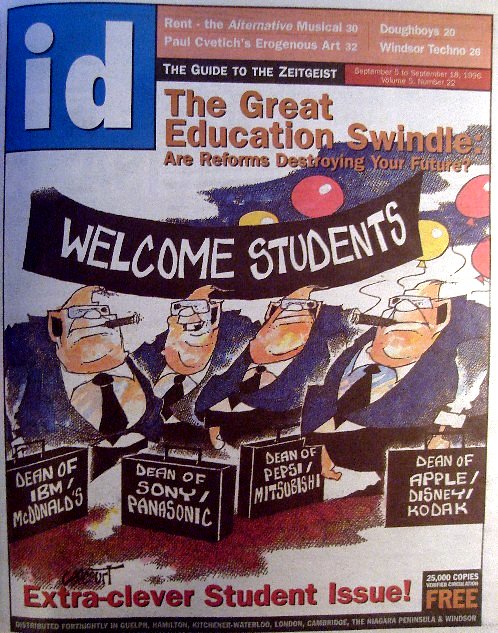Safety at stake
 Saturday, June 13, 2015 at 1:21PM
Saturday, June 13, 2015 at 1:21PM
By David South
Annex Gleaner (Toronto, Canada), February 1997
Toronto’s innovative crime-fighting and crime-prevention experiments face elimination if and when the city is swallowed up by the monolithic megacity. And the Annex’s status as one of Toronto’s safest neighbourhoods could be destroyed by the resulting tax increases.
Since the late 1980s, thinking about crime in Toronto has focused on public safety rather than just cops in cars. Taking what can be called a holistic approach, the city has poured millions into public health programs, street lighting, safety audits and social services, and it has led the region in putting cops back on foot patrol.
Carolyn Whitzman, coordinator of the Safe City Committee – founded in 1989 and a symbol of that attitude change – worries many of the services will find their funds cut or their street-level approach altered.
“I don’t know if people in Toronto realize how privileged they are,” she says. “All these programs have led us to be one of the safest cities in the world. There is nothing like the Safe City Committee in surrounding municipalities. There is nothing like it at Metro – though they do fund safety initiatives.”
The Safe City Committee was the first of its kind in North America and subsequently has been copied by other cities. Initiatives funded by the committee include pamphlets on ending sibling violence, self-defense tips for volunteer workers, a youth drop-in centre at Dufferin Mall and community safety audits.
Whitzman also worries the new meagcity will follow the advice of government consultants KPMG, who recommended replacing some police duties with volunteer labour.
“They recommended store fronts (community police booths) and reporting of accidents be run by volunteers. What if you want a police officer?”
Whitzman also doesn’t like plans to encourage police to spend more time in their cars filing reports on laptop computers. She would rather see them out on the beat.
She also fears school safety programs, like extra lighting, will be jettisoned as school boards chase savings. This also applies to the TTC and public housing. (Whitzman says some housing projects have already cut security due to provincial funding reductions.)
Another factor could jeopardize the Annex’s status as one of the safest neighbourhoods in the city. Higher taxes may chase out homeowners, and the Annex many once again become a haven for transient populations living in rooming houses, as it was in the 1960s and 1970s.
According to Joe Page, a crime analyst at 52 Division for the past quarter century, the Annex had the dubious reputation in the late 1970s of being the busiest neighbourhood in Toronto for police.
It’s a different story today. For example, in the portion of the Annex between Avenue Road and Spadina Road from Dupont south to Bloor, there was one murder in 1995 and none in 1996, and major assaults were down from nine in 1995 to five in 1996. There was one murder in the Little Italy area west of Bathurst in 1996.
If there is a good side to rising crime rates in the surrounding municipalities, it’s that councillors there can no longer ignore public safety issues. This could mean greater sympathy for Toronto’s plight from once-smug suburban councillors.
Whitzman sees hypocrisy in the attitudes of many of the satellite cities. “Scarborough has a bad reputation and other municipalities are not immune to safety issues.”
Other stories from the Annex Gleaner:
Artists Fear Indifference from Megacity
Will the Megacity Mean Mega-Privatization?
This work is licensed under a
Creative Commons Attribution-Noncommercial-No Derivative Works 3.0 License.
 Annex Gleaner,
Annex Gleaner,  By David South,
By David South,  February 1997,
February 1997,  Safe City Committee,
Safe City Committee,  Toronto,
Toronto,  cities,
cities,  innovative,
innovative,  megacities,
megacities,  megacity,
megacity,  neighbourhoods,
neighbourhoods,  safety,
safety,  urban in
urban in  Agenda 21,
Agenda 21,  Annex Gleaner,
Annex Gleaner,  Austerity,
Austerity,  Cities,
Cities,  Data,
Data,  David South Consulting,
David South Consulting,  Digital,
Digital,  Energy,
Energy,  Health,
Health,  Housing,
Housing,  Magazine Stories 1990s,
Magazine Stories 1990s,  Media,
Media,  Poor,
Poor,  Shock Therapy,
Shock Therapy,  Solutions,
Solutions,  Strategy,
Strategy,  Toronto,
Toronto,  Trade,
Trade,  Women,
Women,  Youth
Youth 



